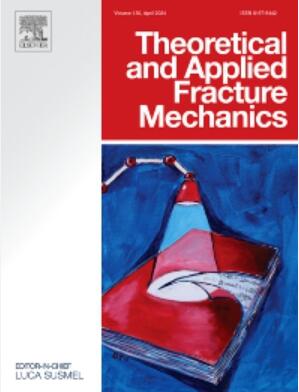Single-point measuring method for J-integral based on the integrating isopleth
IF 5
2区 工程技术
Q1 ENGINEERING, MECHANICAL
引用次数: 0
Abstract
Stem from the path-independence of the J-integral, the computational notion of integrating isopleth is conceived, along which the integral term preserves constant, and the correlated parameters are abstracted to describe the characteristic of the isopleth. Considering the finite plate with a central crack subject to uniform tensile stress, the expression for the token parameter of the J-integral isopleth is deduced based on the general form of the crack field. Accordingly, a single-point method is first proposed exploiting the characteristics of the isopleth. Through the isopleth exploration algorithm and the numerical results, the relations between token parameters and the proposed method are scrupulously verified. Concerning the applicability of the proposed method, numerical tests are performed towards the central cracked thin plate under various loading conditions, while the J-integrals calculated by the single-point method yield high consistency with the real value. Moreover, the optimal locations of the computation point are derived from the relative error distribution, at which guarantees a computational precision within ± 2 %. Overall, the J-integral of the cracked finite plate under symmetric loading can be swiftly acquired utilizing the single-point method, free of the complicated contour integrating.
基于积分等线的j积分单点测量方法
从j积分的路径无关性出发,提出积分等值线的计算概念,使积分项保持常数,并抽象相关参数来描述等值线的特征。考虑中心裂纹受均匀拉应力作用的有限板,根据裂纹场的一般形式,推导出j积分等值面的标志参数表达式。据此,首次提出了利用等等值线特征的单点法。通过等线探测算法和数值结果,严格验证了令牌参数与所提方法之间的关系。针对该方法的适用性,对中心裂纹薄板在不同荷载条件下进行了数值试验,单点法计算的j积分与实际值具有较高的一致性。根据相对误差分布确定计算点的最佳位置,保证了计算精度在±2%以内。总的来说,利用单点法可以快速获得裂纹有限板在对称荷载作用下的j积分,而不必进行复杂的轮廓积分。
本文章由计算机程序翻译,如有差异,请以英文原文为准。
求助全文
约1分钟内获得全文
求助全文
来源期刊

Theoretical and Applied Fracture Mechanics
工程技术-工程:机械
CiteScore
8.40
自引率
18.90%
发文量
435
审稿时长
37 days
期刊介绍:
Theoretical and Applied Fracture Mechanics'' aims & scopes have been re-designed to cover both the theoretical, applied, and numerical aspects associated with those cracking related phenomena taking place, at a micro-, meso-, and macroscopic level, in materials/components/structures of any kind.
The journal aims to cover the cracking/mechanical behaviour of materials/components/structures in those situations involving both time-independent and time-dependent system of external forces/moments (such as, for instance, quasi-static, impulsive, impact, blasting, creep, contact, and fatigue loading). Since, under the above circumstances, the mechanical behaviour of cracked materials/components/structures is also affected by the environmental conditions, the journal would consider also those theoretical/experimental research works investigating the effect of external variables such as, for instance, the effect of corrosive environments as well as of high/low-temperature.
 求助内容:
求助内容: 应助结果提醒方式:
应助结果提醒方式:


